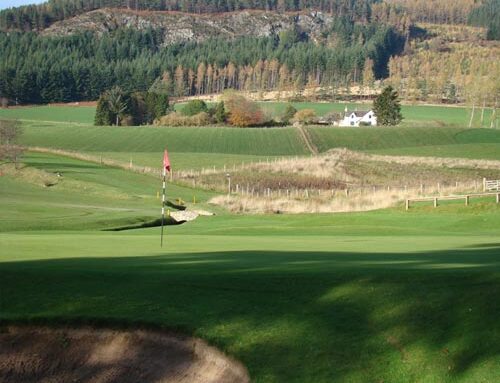Loch Lomond Golf Club
Dunbartonshire, Scotland

Scotland’s rugged beauty isn’t just confined to links courses.
The concept of traveling to Scotland and playing on sandy soil beside a large body of water is almost as old as the sport itself. In addition to the country’s famous links, an unexpected inland course now fits that bill: Loch Lomond Golf Club, courtesy of the club having undertook major course renovation from 2018 to 2021 that included a full drainage and irrigation upgrade complimented with a sand cap to the fairways and semi roughs playing surfaces with 8-10 (!) inches of sand. This massive undertaking involved 90,000 tons of sand hauled in from Fife.
Tom Weiskopf was on site in 2018 prior to the start of this work, and along with the team at Loch Lomond, carried out a full review of the golf course. Only a few minor design tweaks and alterations were implemented such as contour adjustments to improve some surface drainage, more short grass around green locations and a few new back and forward tees. Indeed, Weiskopf’s 30-year plus relationship with the club, complete with annual visits (save for Covid), was one of the most enduring client/architect bonds in modern times until his passing in August, 2022.
That kind of commitment was precisely what club founder David Brench was after when he selected Weiskopf to be the first American to design a course in Scotland in the late 1980s. The opportunity was evident to all as the golf could rotate between playing beside the largest loch (area surface wise) in the United Kingdom and watching balls fall from the sky against the nearby hills to the west. Done right, this would be a course unlike any other. Indeed, Loch Lomond reminds the author of no other course in the world – does it you? Add in the immaculately restored 16th century Rossdhu House and all the ingredients are in place for one of the game’s elite experiences.
Because the setting and the location were so special, this became a very personal project for Weiskopf. He spent heaps of time at this site getting the small points right. By doing so, he avoided the trap that many ‘name’ architects fell into during the golf construction boom of the 1990s as they raced from one project to the next, stamping out course after course, and capitalizing on the hot market. The quality and originality of such architects’ work invariably suffered as they neither studied nor maximized the nuances of the land.
Not so with Weiskopf, who even moved his family for two summers into the Garden Cottage near the third tee so that he could devote his entire energies to this project. The story of him almost perishing in quicksand at 6:00am in the marsh on the fourteenth hole summarizes the enthusiasm that he brought to this undertaking. Given the ten years it took for planning approval, he wasn’t going to squander the opportunity.

For those who prefer impressive, the 16th century Rossdhu House is in the running for favorite clubhouse in golf.
Thanks to the energies spent during the design and construction phase, Weiskopf imbued character into each and every hole, and he never once used bunkers as a crutch. Take the twelfth, for example. The bunkerless green is angled away from the golfer in a similar manner to the twelfth at Augusta National. Instead of a creek, the golfer faces an eight foot deep gully. The left third and right third of the green feature a false front, encouraging the golfer to be well up on his approach. The rub is that the middle back portion of the green that appears as the safe miss to the golfer in the fairway falls away at the rear. Any approach shot must be well judged to stay on the putting surface and the more you play it, the more you appreciate this fact.
The twelfth consistently gave the professionals fits whenever the club hosted the Scottish Open, as they struggled to control the spin on their approach shots. They were playing the hole at 415 yards, you and I might play it at 380 yards but it is wonderful to find a moderate length hole full of so much charm and challenge.
Indeed, in many respects, the design of Loch Lomond was ahead of its time as Weiskopf did a particularly fine job of laying a variety of hazards and obstacles directly across the golfer’s path. Examples include an existing three foot haha stonewall on the second that was restored and incorporated into the hole’s design, a cross hazard bunker for your second shot on the long par five sixth, a bunker in the middle of the ninth fairway, a lake in front of the long approach to the tenth, a fronting gulley at the twelfth green, streams across fairways on the thirteenth and sixteenth holes, and a marsh on the fourteenth.
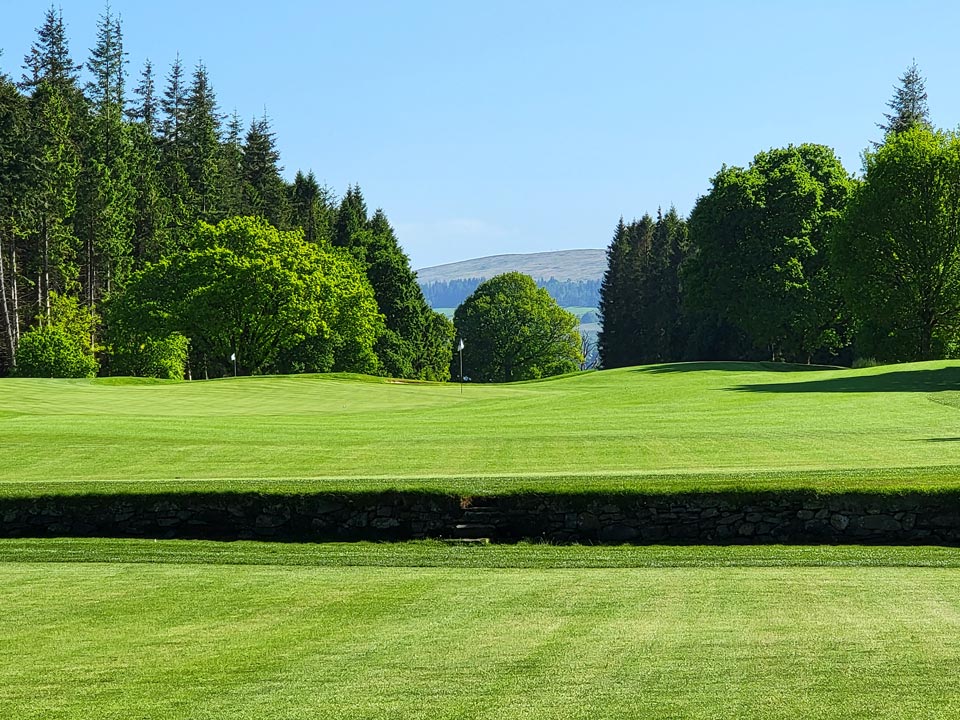
The 2nd plays over this old haha wall. Typical of the rest of the design, beyond it, you will find no fussy features, wonderful restraint, and watching a ball release off the right mound and trickle to the day’s back right hole location is pure joy.
Numerous decisions are the result, and often the day’s hole location dictates the best strategy. By deploying a variety of hazards where they matter the most (i.e. directly in the line of play!), Weiskopf avoided the design mistake that frequently snared many architects in 1990s: pushing everything to the side. In a false quest for fairness and playability, many architects had trouble line only the sides of holes. Such placement of hazards only penalizes the already wayward shot without instilling any strategic conundrums. This is emphatically not the case at Loch Lomond.
Take the ninth for example with the bunker in the middle of the fairway. When the hole is left, most golfers are best to drive to the right of this fairway bunker. In that manner, he has a clear look at the flag with hopes of getting his approach close. However, those who drive left of the bunker are quick to find that the carefully constructed shoulders of the bunkers will shrug off an approach shot from that angle. Conversely, with the hole on the right hand portion, the opposite strategy holds true.

The design at Loch Lomond plays well for all skill sets. At the 9th, the bunker on the left in the photograph above is actual in the middle of the fairway, some 95 yards from the front of the green. It is the prime hazard to avoid for most mortals. Of course, if you are a big hitter, …

… who can carry a ball ~300 yards, you may well elect to try and carry the bunker in the foreground and and have your tee ball run out the final 25 yards and onto the open putting surface. Either way, the 9th asks interesting questions of all players.
Indeed, the ninth, in addition to the short par three eighth that proceeds it, are two of Weiskopf’s gifts to the sport, namely a short par 3 and a short par 4. Back in the 1980s and 1990s, there was a false quest for distance and short holes – be them 3s, 4s or 5s – didn’t fit in with that narrative. To the author, Weiskopf as much as any architect deserves credit for making ‘a drivable par 4’ part of golf’s vocabulary. Though Pete Dye brought back the short two shotter at Harbour Town in the 1960s, neither its walled-off ninth or thirteenth green complexes are exactly ‘drivable’. Both at Loch Lomond’s ninth and fourteenth holes, Weiskopf provided a pathway to the green from the tee for the big hitter while still making the hole an exercise in thought and judgement for the rest of us. Again, a man with fresh ideas who was ahead of his time.
Also, while the really glamorous golf rotates between the loch on the front and the hills on the back, the merit of holes like nine and twelve that fall in between speaks as to how Weiskopf knocked character into every single hole. When you consider the individual caliber of each hole, hole after hole, and then wrap them all up with the overall beautiful presentation of the grounds themselves, you end up with one of the game’s finest inland designs.

This May bush is located between the 13th green and 14th tee and it is in full roar in – you guessed it – the month of May, when this photograph was taken.

The rhododendrons speak as to the temperate climate enjoyed in Scotland for much of the golf season.

In charge of the grounds is Golf Course and Estates Manager David Cole, who has been here for over 25 years.
From the back markers, the course stretches to almost 7,200 yards. The yardages referenced below are from the blue markers, where most single digit handicap players will have a grand time – and be asked to hit every length shot – at 6,705 yards.
Holes to Note
First hole, 400 yards; Befitting a club named Loch Lomond, Weiskopf gives the golfer a taste of what is to come by heading the golfer straight for the loch at the first. True, Weiskopf stopped the hole 150 yards shy of the loch itself but the golfer’s appetite has been whetted.

A draw off the tree before the right fairway bunker makes for the ideal start as …

… the angled green is open along its right side.
Third hole, 465 yards; Alister MacKenzie embraced and fostered the notion of risk/reward 1/2 par holes in most of his designs, especially drivable par 4s and reachable par 5s. That concept fell from favor starting in the 1940s but Weiskopf helped Pete Dye reinvent it several decades later. Several stellar examples exist here, especially at the ninth and fourteenth, but let’s not forget this one that comes early in the round. This three shotter plays downhill and a good drive brings the green within reach in two. Of course, a leaked approach shot to the right might meet a watery grave in the form of a pond beside the green. The aggressive target line is directly at the ghost tree behind the green. Anything right of it and the artful contours that were enthused into the green send the ball to a sad demise.

Back right is a particularly prickly hole location, note the false front directly before it.
Fifth hole, 175 yards; The green complex is equal to the setting as you play toward the loch’s edge. Handsomely bunkered left and right, the green’s left to right tilt makes an up and down from the left hand bunkers an improbability. The long green steps down half way back and the hole location can make as much as a four club difference.

The incomparable setting is the star but the green contours are among the best on the course.
Sixth hole, 580 yards; Every architect dreams of laying out holes along a large body of water but a semi-straight shoreline is hard to which take full advantage. A curving shoreline is preferable (such as found at the Home hole here) as strategic options unfold. In this case, Weiskopf left a thirty yard buffer between the fairway’s edge and the Loch with stately old oak trees periodically found down the right of the hole to break up any linear hint. He also created a cross hazard 150 yards shy of the green, directly between the tee and the green and right where your second shot would otherwise like to land. Add in the small, raised green complex, and this hole poses many interesting asks. Though the water itself shouldn’t really be a part of the playing equation, it sure makes the walk all the more memorable.
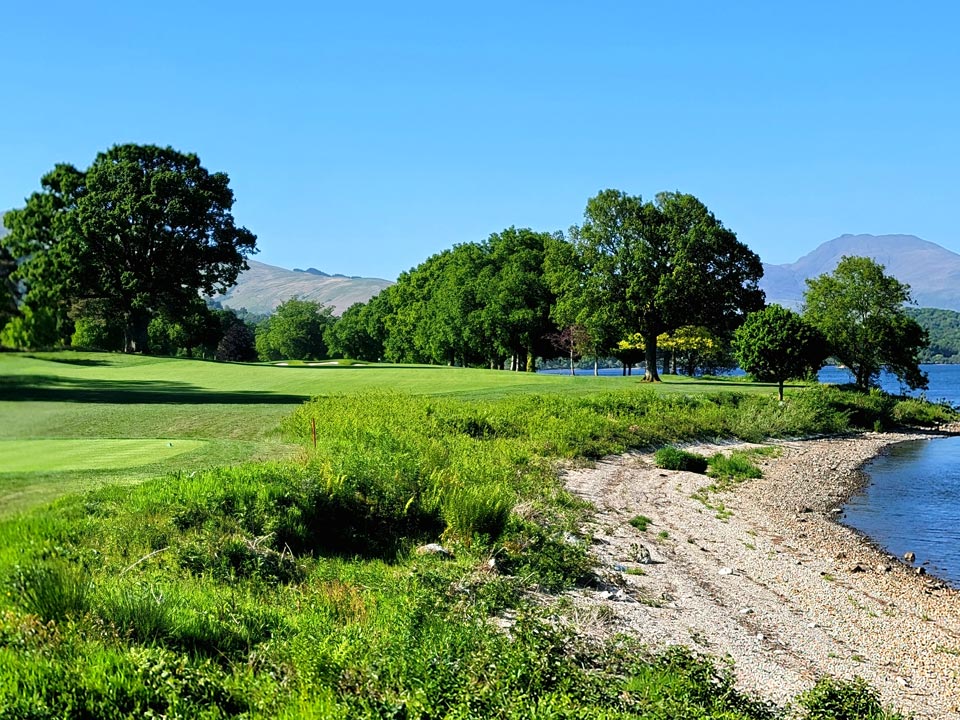
The tees are hard along the bank of the loch at the 6th.

The beautifully placed cross bunker at the sixth, with the small green in the distance.
Seventh hole, 440 yards; Rossdhu House, holes seven through nine and eighteen are on a peninsula that juts into Loch Lomond with Ben Lomond as the distant backdrop. Heading north, the seventh hole is the first hole on this special parcel and it takes full advantage of the moment with the back edge of its green within a dozen paces of the shoreline. Boating activity beyond the green is a frequent occurrence, so don’t line your approach up on a boat as it moves! A clever sucker hole, the golfer actually wants to stay to the outside of this hole as it bends right as the green opens up from there.

There is no compelling reason to flirt with the tree right as …

… as the best approach angle into the 7th green is often from the left side of the fairway. At 50 yards in length, the right greenside bunker is the course’s largest bunker, which accounts for how well it occupies this prominent space. A series of smaller bunkers would have amounted to clutter – and how dreadful that would have been.
Eighth hole, 160 yards; With the loch lapping up directly behind the tee and the regal Rossdhu House looming on the right, the short eighth enjoys a sense of occasion. The deep green is ringed by five bunkers and poses a multitude of different questions based on the day’s hole location. Case in point, today’s front left hole location with helpful slopes to the right and behind asks a different question of the golfer than trying to skip or float a tee shot to a high far back right hole location.

A well struck iron toward the tree’s shadow just right of the flag would likely see the ball bounce once and then slowly trickle backwards to the front left hole location.
Thirteenth hole, 560 yards; Reminiscent of the downhill tenth, the architects built in a lot of elasticity. Whether it is into or down wind, seven fairway bunkers always make the golfer think where he is trying to go off the tee. If you land in one, carrying the creek some 170 yards ahead will prove difficult. And carrying the creek by as much as you can has a distinct advantage given the angled nature of the green. The further back in the fairway you lay up, the worse the angle into the green as you have to contend with several ominous greenside bunkers, all on the left side. Why more architects don’t incorporate similar strategy into their three shot holes remains a mystery.

The sweeping views on the inland holes rival those of the Loch-side for being captivating.
Fourteenth hole, 330 yards; A daring two shot hole, the concept for which Weiskopf (and his long time design partner, Jay Morrish) was famous for incorporating into his courses. A 245 yard carry over the marsh and creek is likely to see the tee ball bound onto the green. Otherwise, the golfer can play left into the fairway provided. The architect encourages you to ‘have a go’ as the approach from the safe route is none too easy with a deep greenside bunker with which to contend.

The tempting 14th with the ‘safe’ route left and the Tiger line right.

Short in distance, the 14th nevertheless packs a punch with this stream turning many a hopefully birdie into a sad bogey for those who apply rash tactics.
Fifteenth hole, 385 yards; For many members, this is their favorite hole – and it is easy to understand why. It embraces the beauty of its surrounds and pulls off the neat trick of making an uphill hole a blast to play. Driver is not an automatic selection as a central bunker is cut into the far upslope 120 yards from the front edge of the green. Kudos to Weiskopf for the manner in which he left the far brow of the hill untouched and how he nestled the green into a low spot beyond it. It epitomizes his light touch of the land while simultaneously, maximizing a hole’s strategic potential.

This view from the tee was taken in late May. Just imagine what it looks like dressed in autumnal colors!

This central hazard is surrounded by fairway and the prudent play is to lay up short of it from the tee and be left with this 155 yard approach.

No matter how far the drive, the putting surface is obscured from view by this hillock. Both the mystery and the allure of the hole is to gauge your approach shot correctly, having the ball release downhill and toward the flag. You won’t know the result until you are ~twenty yards from the green. The anticipation of finding your ball close is scintillating.
Sixteenth hole, 515 yards; For member play, Loch Lomond enjoys the classic 5-3-4 finish, with the sixteenth a reachable three shotter. What a fine time to get a good drive away as it brings the green in reach in two. A stream that feeds off the hills and into the Loch winds its way fifteen yards short of the green. Laying up is often the prudent play – but where is the fun in that?! For the Scottish Opens, the hole played as a beefy two shotter, which wasn’t unreasonable because Weiskopf wisely didn’t place the green flush to the creek.

The 16th heads in a northerly direction with the Loch returning to view for the first time since the 8th.
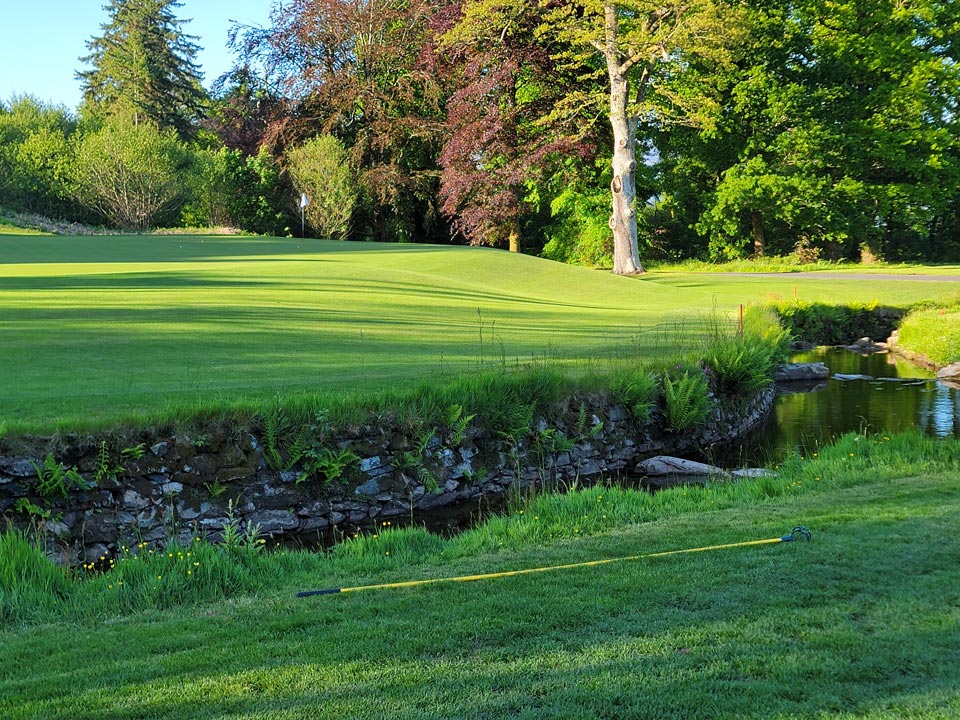
While the 16th is bunkerless, much of its strategy revolves around this fronting stream. Heartbreak occurs when a second shot just carries, only to see the ball shunted to the right by the green’s bank, sending the ball slowly and painfully back into the creek that tracks up the right of the green complex.
Seventeenth hole, 185 yards; Weiskopf’s routing shrewdly returns the golfer to the banks of the loch for its rousing finale. Unlike on the front nine, this time the loch is along the left, though it would take a pretty awful hook to find it on the penultimate hole. Rather, the challenge stems from avoiding the greenside bunkers left and right and finding the right portion of the green with the day’s flag. The green is narrow in front and widens to the rear, so even though front hole locations make the hole play 2 or 3 clubs shorter than rear ones, the shot requirement is even more exact.

Eighteenth hole, 415 yards; A final example of architecture living up to a setting. Loch Lomond is on your left on this classic dogleg left and the right to left pitch of the fairway encourages the golfer to stay as left as possible where a flatter stance is afforded. Easier said than done and even Tom Lehman, an excellent driver and eventual champion, bailed into the right hand fairway bunkers in all four rounds of the 1998 Loch Lomond World Invitational. Weiskopf may have saved his best green for last as the three tiered home green affords numerous thrilling hole locations, with the back right saved for most special occasions.

From the tee, a classic dogleg left unfolds, further cementing Loch Lomond as an excellent, positional driving test.
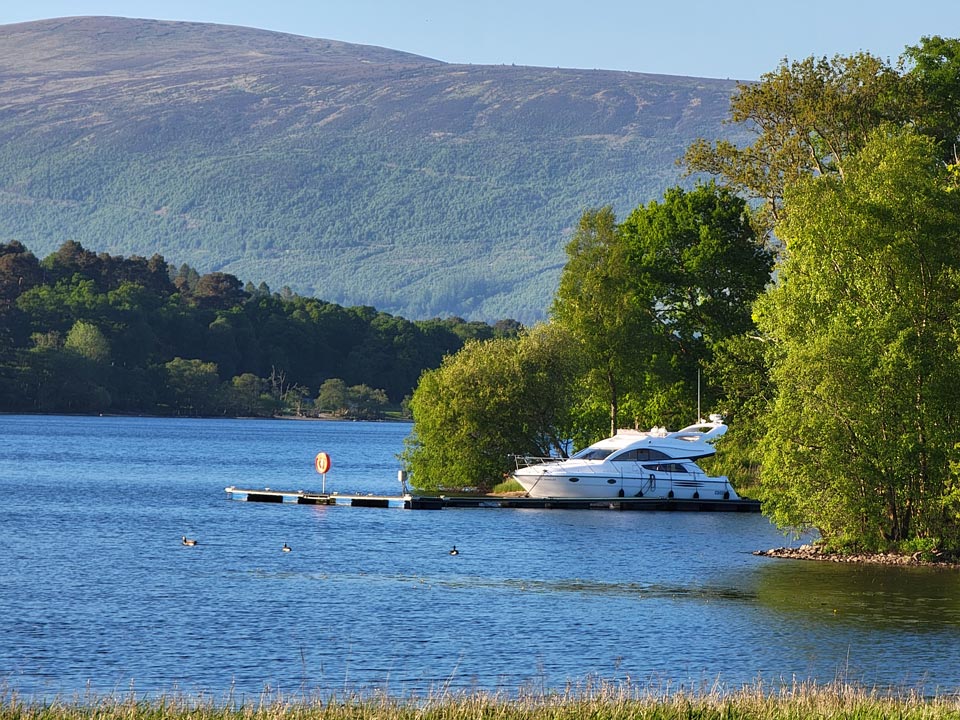
The view to the left as one walks up the fairway is one to savor.

With its Sunday pin location, the elegant finishing green rewards the well positioned drive that flirts with the loch.

One aspect of the club that can’t be stressed enough is its walking culture. Whether you carry your bag, take a trolley, or a caddy, there are few better strolls.
Loch Lomond was always going to be a special course given its unique location, which is perhaps equaled – but never bettered – by any inland course. Lyle Anderson and one of his companies partnered with DMB to provided unfailing support as owner during the crucial stages. However, the ultimate success of the course was dependent on how well the interior holes away from the Loch were designed. And thanks to the time spent on site by Weiskopf, the inland holes were imbued with character and strategic options rarely found in modern architecture. When combined with the holes along the bonnie banks of Loch Lomond, you have an enchanting course as special as its setting.
The End





![Cabot Highlands (Castle Stuart) [2016]](https://golfclubatlas.com/wp-content/uploads/2008/12/Castle-Stuart-Golf-Links-500x383.jpg)
